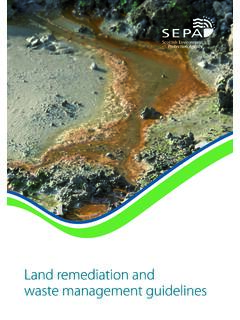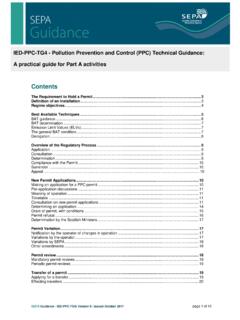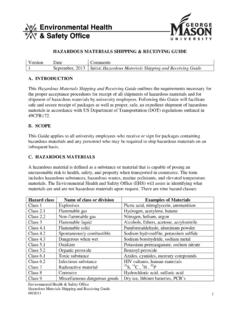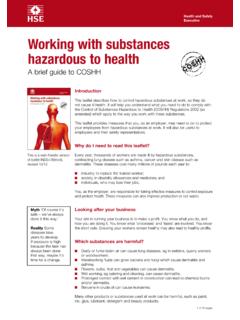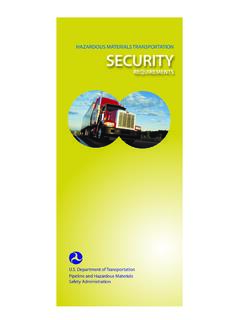Transcription of European waste catalogue EWC guidance Nov 2015
1 guidance on using the European waste catalogue (EWC) to code waste November 2015 2 Table of contents 1. Introduction .. 3 2. How to use this document .. 3 3. Contacting SEPA .. 4 4. The European waste catalogue .. 4 What is the EWC? .. 4 Why is accurate use of the EWC important? .. 4 5. General guidance on using the EWC .. 5 Classifying waste using the EWC .. 5 Use of EWC codes ending in 99 .. 7 6. guidance for completing waste transfer notes and special waste consignment notes .. 8 waste Transfer Notes .. 8 Special waste consignment notes .. 8 7. guidance for specific waste management 9 Introduction .. 9 How to report waste after treatment on-site at a waste management facility.
2 10 Household waste Recycling Centres and Transfer Stations .. 13 Composting and anaerobic digestion plant .. 15 waste incinerators and co-incinerators .. 17 Landfill sites .. 19 Scrap metal and/or End-of-Life Vehicle Authorised Treatment Facilities (ELV-ATFs) .. 21 waste electrical and electronic equipment (WEEE) .. 24 material recovery facilities (MRFs) .. 27 Sewage sludge, septic tank sludge and industrial effluents .. 31 Appendix 1: Acronyms and abbreviations .. 33 Appendix 2: Glossary .. 34 Appendix 3: European waste catalogue .. 35 3 1. Introduction This guidance provides advice on how to use the European waste catalogue (EWC)1 to describe waste . The EWC is a standardised way of describing waste that is used in several reports including quarterly/annual waste data returns to SEPA, waste transfer notes and special waste consignment notes.
3 This guidance will be useful for anyone using the EWC, including operators of waste management sites and activities exempt from the waste Management Licensing Regulations, waste carriers, and waste producers. Consistent use of the EWC across the waste management sector in Scotland will help improve the quality of data recorded for regulation, policy making and reporting. 2. How to use this document The guidance is split into seven parts. Sections 1-5 are generic to all users of the guidance document. Section 6 is aimed any anyone who has to complete waste transfer notes and special waste consignment notes. Section 7 is aimed at operators of waste management sites who are required to submit a site data return to SEPA.
4 Operators should also refer to SEPA s guidance on completing the Licensed/Permitted Site Return form2; SEPA s waste thesaurus3 (which contains an alphabetical list of common waste descriptions with suitable EWC codes); and UK guidance on the definition and classification of hazardous waste4. Section 1 Introduction Section 2 Describes how to use the guidance Section 3 How to contact SEPA Section 4 Explains what the EWC is Section 5 Explains how to use the EWC Section 6 Provides specific guidance for anyone completing a waste transfer note or special waste consignment notes Section 7 Provides specific guidance for operators of specific waste management sites Appendix 1 Acronyms and abbreviations Appendix 2 Glossary Appendix 3 Full European waste catalogue code list 1 :2000D0532:20020101:EN:PDF 2 3 4 4 3.
5 Contacting SEPA If you need to contact SEPA for further help or advice with using EWC codes, please email or call 01786 457700 and asking to speak with a member of the Data Unit. If you have any suggestions on this guidance , or would like more guidance for a specific waste stream or industry sector, please email us at 4. The European waste catalogue What is the EWC? The EWC is a list of waste types, established by the European Commission Decision 2000/532/EC1, which categorises wastes based on a combination of what they are, and the process or activity that produces them. It provides a standard framework for the comparison of waste data (statistics) across all member states.
6 The EWC is divided into 20 chapters, most of which are industry-based, although some are based on materials and processes. Individual waste types are assigned a six-digit code: the first two digits specify the chapter, the next two specify the subchapter, and the last two are specific to the waste type. hazardous (special) wastes are signified by entries where the six-digit EWC code is marked by an asterisk (*). hazardous waste entries can also have a non- hazardous mirror entry . These will appear consecutively in the list, but one will be marked with an asterisk (*), normally with reference to containing hazardous substances , for example: 17 05 03* Soil and stones containing hazardous substances 17 05 04 Soil and stones other than those mentioned in 17 05 03 The full list of EWC codes is provided in Appendix 3 of this guidance .
7 Why is accurate use of the EWC important? The use of EWC codes to describe waste is a legal requirement of the Duty of Care5 for waste which requires the holder of waste to take all reasonable steps to ensure that waste is described in a way that permits its safe handling and management. Transfers of non- hazardous waste must be accompanied by a waste transfer note and transfers of hazardous waste by a special waste consignment note, both of which must include a written description of the waste and appropriate EWC code(s). Correct coding on its own is not sufficient to adequately describe the waste . A clear written description is also necessary to ensure safe onward management of the waste .
8 Operators of waste management facilities and certain exempt activities are required to submit data returns to SEPA on a quarterly or annual basis. Accurate and consistent reporting on the types of waste produced and managed in Scotland relies almost entirely on the EWC codes reported by these operators. This information is important as it underpins the development of Scottish Government policy, and is used for national and European reporting and to inform decisions on the development of new waste infrastructure. waste data is also essential to support the Zero waste Plan6 and Safeguarding Scotland s Resources programme7 and to monitor the targets in these plans.
9 5 6 7 5 EWC codes describe waste consistently and, along with an accurate waste description, they are used whenever waste is reported: waste transfer notes, special waste consignment notes and waste data returns received by SEPA. The electronic capture of data on transfers of non- hazardous waste is now possible through edoc8 (Electronic Duty of Care). Data in edoc is used to produce reports for waste producers, waste management companies (which in turn may use the information to report to SEPA) and waste regulators so it is essential that these are based on good quality data using accurate EWC codes and descriptions.
10 5. General guidance on using the EWC This section explains the step-by-step procedure that users should follow to describe their waste using the EWC. It also explains the use of EWC codes ending in 99 . Classifying waste using the EWC In the first instance, you should use the flowchart in Figure 1 to assign an appropriate code to your waste . In order to do this you will need to know: what type of business produced the waste ; where the waste was generated, the process or activity that produced it; the description of the waste ; if it is hazardous (special) waste ( guidance on how to classify and assess hazardous (special) waste can be found in Technical guidance WM39).
